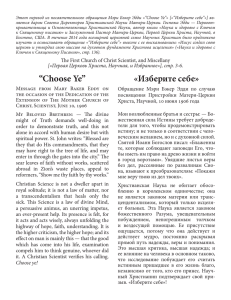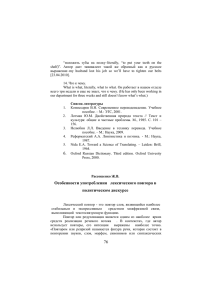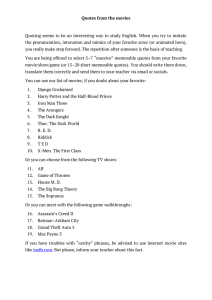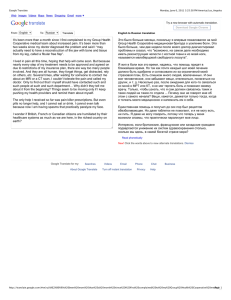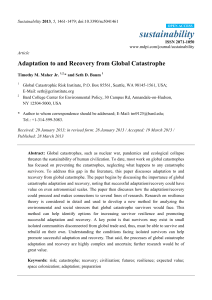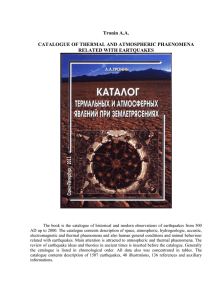Развитие макроподходов в изучении цивилизаций и их
реклама
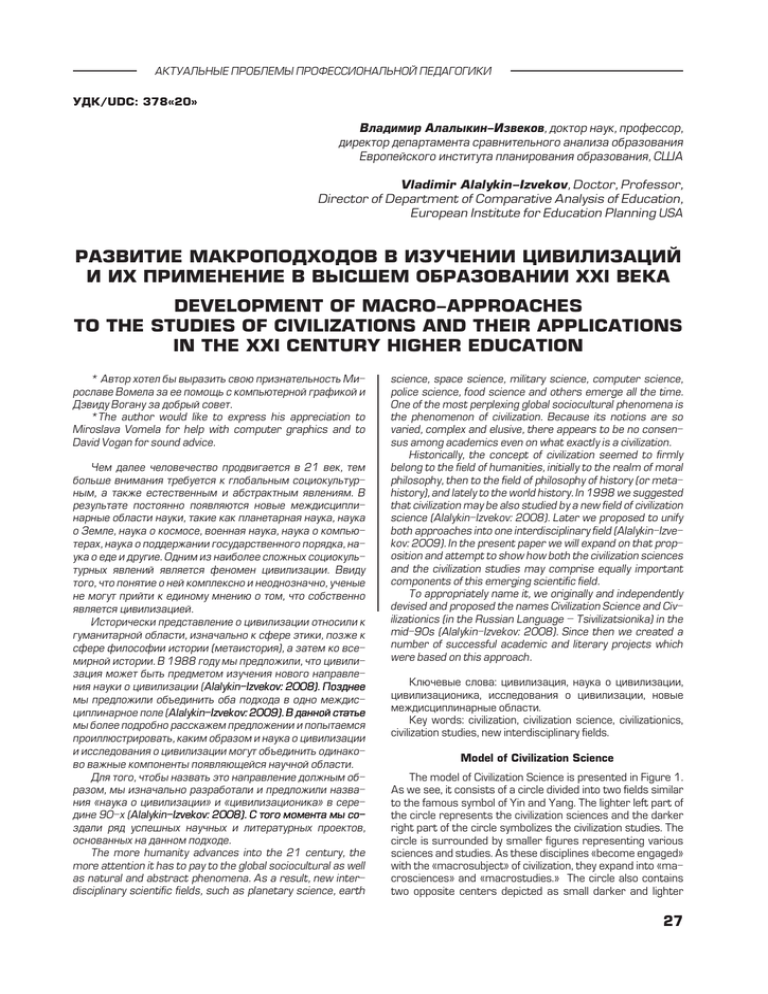
Актуальные проблемы профессиональной педагогики УДК/UDC: 378«20» Владимир Алалыкин-Извеков, доктор наук, профессор, директор департамента сравнительного анализа образования Европейского института планирования образования, США Vladimir Alalykin-Izvekov, Doctor, Professor, Director of Department of Comparative Analysis of Education, European Institute for Education Planning USA Развитие макроподходов в изучении цивилизаций и их применение в высшем образовании XXI века Dеvelopment of macro-approaches to the studies of civilizations and their applications in the XXI century higher education * Автор хотел бы выразить свою признательность Мирославе Вомела за ее помощь с компьютерной графикой и Дэвиду Вогану за добрый совет. *The author would like to express his appreciation to Miroslava Vomela for help with computer graphics and to David Vogan for sound advice. Чем далее человечество продвигается в 21 век, тем больше внимания требуется к глобальным социокультурным, а также естественным и абстрактным явлениям. В результате постоянно появляются новые междисциплинарные области науки, такие как планетарная наука, наука о Земле, наука о космосе, военная наука, наука о компьютерах, наука о поддержании государственного порядка, наука о еде и другие. Одним из наиболее сложных социокультурных явлений является феномен цивилизации. Ввиду того, что понятие о ней комплексно и неоднозначно, ученые не могут прийти к единому мнению о том, что собственно является цивилизацией. Исторически представление о цивилизации относили к гуманитарной области, изначально к сфере этики, позже к сфере философии истории (метаистория), а затем ко всемирной истории. В 1988 году мы предложили, что цивилизация может быть предметом изучения нового направления науки о цивилизации (��������������������������������� Alalykin������������������������� -������������������������ Izvekov����������������� : 2008). Позднее мы предложили объединить оба подхода в одно междисциплинарное поле (����������������������������������������� Alalykin��������������������������������� -�������������������������������� Izvekov������������������������� : 2009). В данной статье мы более подробно расскажем предложении и попытаемся проиллюстрировать, каким образом и наука о цивилизации и исследования о цивилизации могут объединить одинаково важные компоненты появляющейся научной области. Для того, чтобы назвать это направление должным образом, мы изначально разработали и предложили названия «наука о цивилизации» и «цивилизационика» в середине 90-х (���������������������������������������������� Alalykin�������������������������������������� -������������������������������������� Izvekov������������������������������ : 2008). С того момента мы создали ряд успешных научных и литературных проектов, основанных на данном подходе. The more humanity advances into the 21 century, the more attention it has to pay to the global sociocultural as well as natural and abstract phenomena. As a result, new interdisciplinary scientific fields, such as planetary science, earth science, space science, military science, computer science, police science, food science and others emerge all the time. One of the most perplexing global sociocultural phenomena is the phenomenon of civilization. Because its notions are so varied, complex and elusive, there appears to be no consensus among academics even on what exactly is a civilization. Historically, the concept of civilization seemed to firmly belong to the field of humanities, initially to the realm of moral philosophy, then to the field of philosophy of history (or metahistory), and lately to the world history. In 1998 we suggested that civilization may be also studied by a new field of civilization science (Alalykin-Izvekov: 2008). Later we proposed to unify both approaches into one interdisciplinary field (Alalykin-Izvekov: 2009). In the present paper we will expand on that proposition and attempt to show how both the civilization sciences and the civilization studies may comprise equally important components of this emerging scientific field. To appropriately name it, we originally and independently devised and proposed the names Civilization Science and Civilizationics (in the Russian Language – Tsivilizatsionika) in the mid-90s (Alalykin-Izvekov: 2008). Since then we created a number of successful academic and literary projects which were based on this approach. Ключевые слова: цивилизация, наука о цивилизации, цивилизационика, исследования о цивилизации, новые междисциплинарные области. Key words: civilization, civilization science, civilizationics, civilization studies, new interdisciplinary fields. Model of Civilization Science The model of Civilization Science is presented in Figure 1. As we see, it consists of a circle divided into two fields similar to the famous symbol of Yin and Yang. The lighter left part of the circle represents the civilization sciences and the darker right part of the circle symbolizes the civilization studies. The circle is surrounded by smaller figures representing various sciences and studies. As these disciplines «become engaged» with the «macrosubject» of civilization, they expand into «macrosciences» and «macrostudies.» The circle also contains two opposite centers depicted as small darker and lighter 27 topical problems of professional pedagogics circles. They represent «the opposite» which is always present where any duality exists. The sciences which are closer to the circle symbolizing the civilization studies (depicted as a dark circle) are less «scientific,» for example macrophilosophy or macrogeopoltics. Following the same logic, the civilization studies which are closer to the light circle, are more «scientific,» for example macroarcheology or macrolinguistics. Thus, the model has a systemic nature. Figure 1. Model of Civilizationics. List of the proposed civilization sciences and civilization studies Below we offer a list of the proposed civilization sciences and civilization studies. The «prototypes» for those new disciplines are derived from traditional scientific fields of humanities and social, natural, formal and applied sciences. It is easy to notice that to create a name for the civilization sciences and the civilization studies we usually add a qualifier, such as macro-, world, global or meta– to the name of a traditional science or a study. Since an urgent social need for such macro-approaches has existed already for some time, a few of them, for example, macrohistory, macrosociology, macroeconomics and macrolinguistics, were already established earlier. Humanities Macroarhaeology; macroarts; comparative study of civilizations; macrocultural studies; macroclassics; macroethics; macrofolklore; macrohistory; metahistory; macrolinguistics; macroliterature; macromythology; macronumismatics; macrophilosophy; macrophilosophy of history; macrotheology. Social Sciences Macroanthropology; macroculturology; macrocliometrics; macrocliodynamics; macrodemographics; macroeconomics; macroethnology; macroethnography; macrogeography; macrogeopolitics; macropsychology; macropolitology; macrosociology. Natural Sciences Macrobiology; macrobotany, macroclimatology; macro- 28 ecology; macroepidemiology; macroenvironmental sciences; macrogeography; macrogeology; macrogenetics; macrohydrology; macrometeorology; macronutrition; macrooceanography; macropaleontology; macroseismology; macrovolcanology; macrovirology; macrozoology. Formal Sciences Macrocybernetics; macrodemographics; macroecosystems science; macroergonomics; ecological macrosystems science; macroeconometrics; macrogames science; macroinformation science; information macrosystems; information macrotechnology; macroknowledge management; living macrosystems science; macromathematics; macromodels science; macrosystems science; macrostatistics; social macrodynamics science, macrosystems ecology, living macrosystems science; sociotechnical macrosystems science; worldsystems. Applied Sciences Macroagronomy; macroagriculture; macroagrology; macroaquaculture; macroarchitecture; macrobusiness administration/management; macroeducation; macromarketing; macroenrepreneurship; macroenvironmental science; macroergonomics; macroemergency management; macrofinance; macrofitness; global health sciences; macrohydrology; macrojurisprudence; macrometeorology; mass macrotransit; macrolibrary science; macromuseology; macroclimate science; mass macrocommunication; macromanagement; macrodivinity; macromedia; macrolaw; macromarketing; macroeducation; macroengineering (including macrotransportation, macrotelecommunication systems, etc.), macronutrition; macroproject management; macrorisk management and insurance; macrosystems science. Matrix of the civilization sciences and the civilization studies After we saw what kind of scientific arsenal could be used to study civilizations in all their various, sometimes quite unexpected representations, the questions may arise as to what role each civilization science or civilization study could play, as well as to what interaction or an interplay could possibly emerge between them. A civilization sciences and civilization studies matrix would help to visualize those processes. In it we could see the definition of a civilization, for example, «a global culture or a cultural supersystem.» In the relevant columns the corresponding civilization sciences and civilization studies would be listed, for example «macrophilosophy,» «macrohistory,» «macroculturology,» «macrosociology,» as well as «macrosystems science.» Therefore, the main characteristics, patterns of development and evolution, uniformities, principles, laws and other features of civilizations as global cultures would be expected to emerge from interaction and cooperation between those civilization-related disciplines. Using this civilization science-based approach, a civilization may be studied, for example, as a major stage in a society’s intellectual, cultural and moral refinement or development; major moral codex; global «wave» ; global culture or cultural supersystem; global religion; extensive time period; influential way of thought; major linguistic group; global network; ecumene; macrosystem; «organism» ; global or complex society; empire, global power or superpower; global or major ethnic group; global or major economy; archetype; global or influential ideology; extensive geographical area; world-system; ethical code or standard of behavior; universal «interface» with Creator, Nature and Society; global environ- Актуальные проблемы профессиональной педагогики ment; utilitarian facilities / urban comforts / various lifestyles or all of the above. Let’s consider several other scenarios: 1. A researcher defines civilization as a complex society which is a carrier of an advanced culture. A glance at the matrix would show that this type of civilization is to be studied by the comparative study of civilizations, macroculturology, and macrosociology. 2. Another academic proposes that civilization is a network between various major trade centers. A look at the matrix would show that this type of civilization is to be studied by the comparative study of civilizations, macrosociology, macroeconomics as well as by the macrosystems science. 3. Yet another scientist suggests that civilization is an archetype. A look at the matrix would suggest that this type of civilization is to be researched by macromythology, comparative study of civilizations and macropsychology. Macroculturology – a science of civilizations as global culture. A more elaborate example may be a description of the science of macroculturology. In one of our recent publications we describe this would be scientific discipline, propose within its realm the Unified Theory of Evolution of Cultures and Civilizations as well as offer structure and dynamics of a primitive culture, subculture, culture, civilization and a supercivilization. We further present the evolution of cultures and civilizations in a number of computerized models and offer propositions regarding the pattern of it (Alalykin-Izvekov: 2009). Conclusions 1. Emergence of new multidisciplinary scientific fields reflects an urgent social need for the in-depth study of the global sociocultural as well as natural and abstract phenomena. 2. Civilization Science (Civilizationics, Tsivilizatsionika) and related sciences and studies may offer reliable, comprehensive, consistent and scientifically sound ways to study any type or aspect of a civilization. 3. Macroculturology – a science of civilizations as global cultures is presented. 4. United Theory of Evolution of Cultures and Civilizations within the realm of macroculturology is introduced. 5. The achieved results may be applicable on the advanced levels of higher education, for example in such new courses as macrohistory, macrotheology, macrosociology, macropolitology, macroculturology, macrolinguistics, macroethics, macromythology, etc. References 1. Alalykin-Izvekov, V. (2008) [with a co-author] Civilization(s) Science and Its Practical Applications. Abstracts of the ISCSC 38th World Conference. Saint John, New Brunswick, Canada: University of New Brunswick. 2. Alalykin-Izvekov, V. (2009) From Sorokin to Huntington and Beyond – Civilizations in Times of Change, Transition and Crisis. – 2009 ISCSC Kalamazoo Conference Proceedings, International Society for the Comparative Study of Civilizations, ISCSC Press. 29
